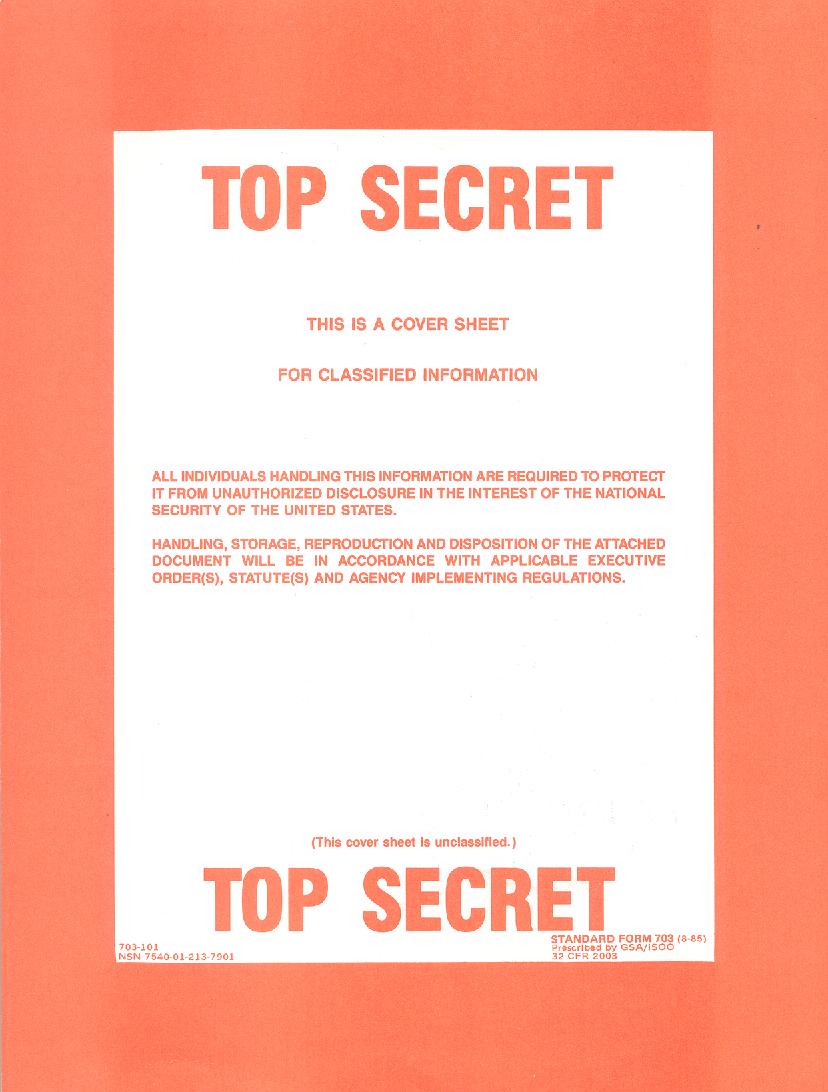U.S. Intelligence Agencies Rethink Classification Policy
 The United States government is thinking about coming up with a coherent system for dealing with classified information. Steven Aftergood has details.
The United States government is thinking about coming up with a coherent system for dealing with classified information. Steven Aftergood has details.
U.S. intelligence agencies have embarked upon a process to develop a uniform classification policy and a single classification guide that could be used by the entire U.S. intelligence community, according to a newly obtained report (pdf) from the Office of the Director of National Intelligence.
The way that intelligence agencies classify information is not only frustrating to outsiders, as it is intended to be, but it has also impeded interagency cooperation and degraded agency performance.
[…]
“The definitions of ‘national security’ and what constitutes ‘intelligence’ — and thus what must be classified — are unclear,” the review team found. “Many interpretations exist concerning what constitutes harm or the degree of harm that might result from improper disclosure of the information, often leading to inconsistent or contradictory guidelines from different agencies.” “There appears to be no common understanding of classification levels among the classification guides reviewed by the team, nor any consistent guidance as to what constitutes ‘damage,’ ‘serious damage,’ or ‘exceptionally grave damage’ to national security… There is wide variance in application of classification levels.”
Among the recommendations presented in the initial review were that original classification authorities should specify clearly the basis for classifying information, e.g. whether the sensitivity derives from the content of the information, or the source of the information, or the method by which it is analyzed, the date or location it was acquired, etc. Current policy requires that the classifier be “able” to describe the basis for classification but not that he or she in fact do so.
Coming up with a less lousy system shouldn’t be hard but Steven is rightly skeptical:
First, it assumes that consistency in classification is intrinsically desirable and should therefore be imposed by a community-wide classification guide. But consistency is at most a secondary virtue. When a classification policy is poorly justified, it is preferable for it to be inconsistently applied, as in the case of intelligence budget secrecy (see below).
Second, the review does not touch upon what is probably the single most necessary change in intelligence classification policy, namely the need to narrow the definition of intelligence sources and methods that require protection. Almost anything can serve as an intelligence source or method, including a subscription to the daily newspaper. But not every intelligence source or method requires or deserves classification or other protection from disclosure.
It’s axiomatic that coming up with a system that is both standardized and lousy is a bad thing. But the second issue is really the key: Too many things are deemed classifiable and, once that decision is made, it’s hard to unclassify the material because of bureaucratic inertia.
Researching my dissertation in the early 1990s, I did archival research of military documents from 1943-1948 relating to the “roles and missions” debate (that is, what the proper roles of the Army, Navy, Air Force, and Marines were vis-a-vis one another). An amazing amount of that material had only recently been de-classified even though none of it should ever have been classified. There were no technical details involved in these documents that would have been of value to the enemy; it was nothing more than bureaucratic infighting about whether the Navy should be permitted to keep its airplanes now that there was an Air Force; whether the Marines should continue to be allowed to maintain, in effect, a second land Army; and so forth. Indeed, even press releases that were to be published in the New York Times a few hours hence were classified. That’s simply nonsense.
Sometimes, incidentally, the reverse error occurs. As the leader of a rocket artillery firing platoon in the closing days of the Cold War, I had a “battle book” containing maps with the detailed locations to which my unit would initially deploy for war. It contained the locations of my three launchers, my fire direction center, the other platoons in the battery, the battery tactical operations center, the other firing batteries, and the battalion headquarters. I was classified SECRET, which is the lowest level anyone bothers to pay attention to.





I suspect this will do little to change the classification process, but will rather change how intelligence categories that are not classifications in themselves are handled, i.e., the compartmented “code word†stuff such as the WW II ULTRA. Wikipedia covers this distinction.
This compartmenting leads to some strange results out of the Intelligence Community on occasion, such as a non-compartmented intelligence assessment that is pretty much the opposite of the “all sources†assessment.
Another case is military participation in the drug war – if you have an informant, is the information obtained considered compartmented HUMINT that few involved have access to? This rapidly becomes a case of “I have a secret, just trust me.”
Both the classification and compartmentalization rules are out of the Cold War and need updating but there is no perfect solution. It does not matter if an intelligence analyst working Chinese political issues has a clearance, they still have no need for the blueprints to the US nuclear arsenal. Technical details should not be automatically declassified.
Ditto Background Investigations, which keeps an army of folks (now outsourced) knocking on neighbor’s doors.
I joined the Air Force in 2000 and spent the next five years in the Intelligence field, both at strategic and tactical levels. Consequently, I worked with classified materials literally every day. When I joined, we were still pretty much fighting the Soviets; a lot of my training focused on Russian tanks, ICBM installations, Naval bases, etc. These are things that really don’t go very far very fast (lest they fall apart from rust), and generally were conducive to massive fixed intelligence organizations. THIS was classified at THIS level, because it always has been, and so on.
The GWOT has not been fought at a strategic level, though. It’s almost all tactical, and that means that intelligence has to be disseminated FAST – which just doesn’t happen to Top Secret information. So, either classify the entire network, or…don’t. A lot of things were properly reclassified from the higher levels that they had been at in the Cold War, and other technologies were tried to allow secure use of higher-classification stuff in more places. Compartmentalization, used before, now seemed to be the REAL classified stuff, and the stuff that was vanilla Top Secret/Secret was less important.
What I’m getting at is that this new setup is crystallizing. If I get something from a Top Secret compartmented network, in the absence of clear markings, I have to assume that that information is therefore Top Secret compartmented. Trust me, portion markings – segmenting out each paragraph or item with its proper classification – are not nearly as common as they should be, thus making it inevitable to assume that ALL of it is classified a particular way.
In some cases, we don’t NEED to classify things until something specific is done. Predator UAV video doesn’t have to be classified – although encryption is something we would want – because it’s just video from an aircraft, really. Once that video is analyzed, however, it has to become classified as the information in it has been ‘decoded’ and placed into a usable form. As an Analyst, of course, I like this idea, but more to the point, it has potential to recognize tactical realities and cost that much less, as classification issues only occur at the provider-customer level.
I apologize for the long form, but I can’t turn off essay mode that easily :/